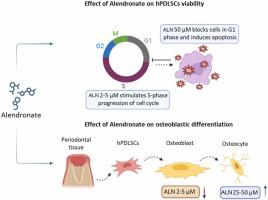European Journal of Cell Biology ( IF 6.6 ) Pub Date : 2023-08-15 , DOI: 10.1016/j.ejcb.2023.151354 Anna Di Vito 1 , Emanuela Chiarella 1 , Jessica Sovereto 1 , Jessica Bria 1 , Ida Daniela Perrotta 2 , Alessandro Salatino 3 , Francesco Baudi 1 , Alessandro Sacco 1 , Alessandro Antonelli 3 , Flavia Biamonte 1 , Tullio Barni 1 , Amerigo Giudice 3

|
Alendronate (ALN) is a second-generation bisphosphonate widely used for osteoporosis and cancer-induced bone lesions. Many studies have confirmed a strong relationship between osteonecrosis of the jaws (ONJ) development and oral bisphosphonates, especially ALN, although the molecular mechanisms underlying this pathology have not yet been elucidated. The reduction in bone turnover and vascularization usually observed in ONJ are the result of ALN action on different cell types harboured in oral microenvironment, such as osteoclasts, endothelial cells, and periodontal ligament stem cells (PDLSCs). In this perspective, the present study aims to investigate the effects of different ALN concentrations (2 μM, 5 μM, 10 μM, 25 μM, 50 μM) on the phenotype and functional properties of human PDLSCs (hPDLSCs). hPDLSCs showed a decrease in cell viability (MTT assay) only when treated with ALN concentration of 10 μM or larger for 48 h and 72 h. Cell cycle analysis revealed a moderate increase in proportion of S-phase cells after exposure to low ALN concentration (2–5 μM), an effect that was reverted after exposure to 10–50 μM ALN. Conversely, cell death was evidenced via Annexin V/PI assay at very high concentration of ALN (50 μM) after 4 days of treatment. In addition, we explored whether the effects of ALN on hPDLSCs growth and survival can be mediated by its ability to modulate oxidative stress. To this, we quantified the intracellular ROS amount and lipid peroxidation by using DCF probe and Bodipy staining, respectively. Flow cytometry analysis showed that ALN induced a dose-dependent reduction of intracellular oxidative stress and lipid peroxidation upon treatment with low concentrations at both 48 h and 72 h. Increased levels of oxidative stress was reported at 50 μM ALN and was also confirmed via TEM analysis. Despite the stability of the cellular immunophenotype, hPDLSCs showed impaired mobility after ALN exposure. Chronic exposure (7–14 days) to ALN in the range of 2–10 μM significantly decreased the expression of the differentiation-related factors ALP, RUNX2, COLI, and OPN as well as the osteogenic ability of hPDLSCs compared with untreated cells. Conversely, higher doses were found to be neutral. Our findings indicated that the effects of ALN on hPDLSCs behavior are dose-dependent and suggest a role for oxidative stress in ALN-induced cell death that may lead to novel therapeutic approaches for ONJ.
中文翻译:

氨基二膦酸盐阿仑膦酸钠对人牙周膜干细胞药理学调节的新见解
阿仑膦酸钠(ALN)是第二代双膦酸盐,广泛用于治疗骨质疏松症和癌症引起的骨病变。许多研究已证实颌骨坏死 (ONJ) 的发生与口服双磷酸盐(尤其是 ALN)之间存在密切关系,尽管这种病理学背后的分子机制尚未阐明。通常在 ONJ 中观察到的骨转换和血管化减少是 ALN 对口腔微环境中不同细胞类型(如破骨细胞、内皮细胞和牙周膜干细胞 (PDLSC))作用的结果。从这个角度来看,本研究旨在研究不同ALN浓度(2 μM、5 μM、10 μM、25 μM、50 μM)对人PDLSC(hPDLSC)表型和功能特性的影响。仅当用 10 μM 或更高浓度的 ALN 处理 48 小时和 72 小时时,hPDLSC 才显示细胞活力下降(MTT 测定)。细胞周期分析显示,暴露于低浓度 ALN (2–5 μM) 后,S 期细胞比例适度增加,但暴露于 10–50 μM ALN 后,这种效应又恢复了。相反,处理 4 天后,在非常高浓度的 ALN (50 μM) 下通过膜联蛋白 V/PI 测定证明细胞死亡。此外,我们还探讨了 ALN 对 hPDLSC 生长和存活的影响是否可以通过其调节氧化应激的能力来介导。为此,我们分别使用 DCF 探针和 Bodipy 染色定量细胞内 ROS 量和脂质过氧化。流式细胞术分析表明,低浓度 ALN 在 48 小时和 72 小时处理后,可诱导细胞内氧化应激和脂质过氧化的剂量依赖性减少。据报道,50 μM ALN 时氧化应激水平增加,并通过 TEM 分析得到证实。尽管细胞免疫表型稳定,但 hPDLSC 在 ALN 暴露后表现出活动性受损。与未处理的细胞相比,长期暴露(7-14天)2-10 μM范围内的ALN显着降低了分化相关因子ALP、RUNX2、COLI和OPN的表达以及hPDLSCs的成骨能力。相反,较高剂量被发现是中性的。我们的研究结果表明,ALN 对 hPDLSC 行为的影响是剂量依赖性的,并表明氧化应激在 ALN 诱导的细胞死亡中发挥作用,这可能会导致 ONJ 的新治疗方法。



























 京公网安备 11010802027423号
京公网安备 11010802027423号